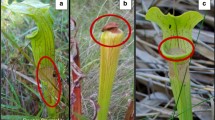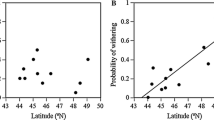Abstract
Euphorbia clivicola R.A. Dyer is a Critically Endangered Northern Province endemic confined to two populations that have declined drastically over the last decade. One population is protected within a Nature Reserve, while the other occurs in a peri-urban area. In order to determine the causes of the population declines, herbivory damage to plants in both the protected and urban populations was quantified and the effects of herbivory on various aspects of the population biology were assessed. Mountain reedbuck are believed to have been responsible for the herbivory in the protected population. Herbivory on the above-ground branches probably caused the small sizes of protected plants. These were on average less than half the size of urban plants. Herbivory caused a reduction in the number of flowers and fruit produced per protected plant and may have prevented the maturation of flowers into fruit, thereby reducing the total regenerative output of the population. An eight-year absence of fire had resulted in the build-up of a dense moribund grass layer. The selection of E. clivicola plants by mountain reedbuck may therefore have been due to their relatively high nutritional value and accessibility in the thick moribund grass layer. Fencing off the population to prevent entry of herbivores, and implementing a more suitable fire management programme is recommended, as is the adoption of a new IUCN status for the species of Critically Endangered (CR A1).
Similar content being viewed by others
References
Acocks, J. P. H. 1988. Veld Types of South Africa. Memoirs of the Botanical Survey of South Africa No. 57. Botanical Research Institute, South Africa.
Beukes, P. C. 1987. Responses of grey rhebuck and bontebok to controlled fires in coastal renosterveld. South African J. Wildlife Res. 17 (3): 103–108.
Bossard, C. C. & Rejmanek, M. 1994. Herbivory, growth, seed production, and resprouting of an exotic invasive shrub. Biol. Cons. 67: 193–200.
Bruce, E. A., Brueckner, A., Dyer, R. A., Kies, P. & Verdoorn, J. C. 1951. Newly described species. Bothalia 6 (1)221: 213–248.
Caughley, G. 1994. Directions in conservation biology. J. An. Ecol. 63: 215–244.
Cowling, R. M. & Hilton-Taylor, C. 1994. Patterns of plant diversity and endemism in southern Africa: an overview. Pp. 31–52. In: Huntley, B. J. (ed.), Botanical diversity in southern Africa. Strelitzia 1. National Botanical Institute, Pretoria.
Crawley, M. J. & Weiner, J. 1991. Plant size variation and vertebrate herbivory: Winter wheat grazed by rabbits. J. Appl. Ecol. 28: 154–172.
de Jong, T. J. & Klinkhamer, P. G. L. 1989. Limiting factors for seed production in Cynoglossum officinale. Oecologia 80: 167–172.
Doak, D. F. 1992. Lifetime impacts of herbivory for a perennial plant. Ecology 73: 2086–2099.
Dudley, C. O. 1997. The candelabra tree (Euphorbia ingens): a source of water for black rhinoceros in Liwonde National Park, Malawi. Koedoe 40 (1): 57–62.
Ehrlén, J. 1995. Demography of the perennial herb Lathyrus vernus. I. Herbivory and individual performance. J. Ecol. 83: 287–295.
Fiedler, P. L. 1987. Life history and population dynamics of rare and common Mariposa lilies (Calochortus pursh: Liliaceae). J. Ecol. 75: 977–995.
Fourie, S. P. 1986. The Transvaal, South Africa, Threatened Plants Programme. Biol. Cons. 37: 23–42.
Gange, A. C. & Brown, V. K. 1989. Insect herbivory affects size variability in plant populations. OIKOS 56: 351–356.
Goodrich, J. M. & Buskirk, S. W. 1994. Control of abundant native vertebrates for conservation of endangered species. Cons. Biol. 9: 1357–1364.
Hall, A. V., de Winter, M., de Winter, B. & van Oosterhout, S.A.M. 1980. Threatened plants of Southern Africa. South African National Scientific Programmes Report No. 45.
Hendrix, S. D. 1988. Herbivory and its impact on plant reproduction. Pp. 246–263. In: Plant Reproductive Ecology. Patterns and Strategies. Oxford University Press, New York.
Hilton-Taylor, C. 1996. Red Data List of Southern African Plants. Strelitzia, 4. National Botanical Institute, Pretoria.
Hilton-Taylor, C. 1997. Red Data List of southern African plants. 2. Corrections and additions. Bothalia 27 (2): 195–209.
Knowles, L. 1995. The ecology and population biology of Euphorbia barnardii White, Dyer & Sloan, a vulnerable North325 ern Province endemic. Honours Thesis. Department of Botany. University of the Witwatersrand, South Africa.
Moran, V. C. & Hoffmann, J. H. 1989. The effects of herbivory by a weevil species, acting alone and unrestrained by natural enemies, on growth and phenology of the weed Sesbania punicea. J. Applied Ecol. 26: 967–977.
Pfab, M. F. 1997. Population biology and ecology of Euphorbia clivicola R. A. Dyer, an endangered plant endemic to the Northern Province of South Africa. Master of Science Research Report. The University of the Witwatersrand, South Africa.
Pfab, M. F. & Witkowski, E. T. F. 1999. Fire survival of the Critically Endangered succulent, Euphorbia clivicola R.A. Dyer-fireavoider or fire-tolerant. African J. Ecol., in press.
Raal, P. A. 1986. Conservation Plan.Euphorbia clivicola. Transvaal Provincial Administration, Nature Conservation Division, South Africa.
Raal, P. A. 1988. Ecology and population biology of Euphorbia perangusta (Euphorbiaceae) in the Transvaal, South Africa. Bothalia 18: 105–110.
Rizk, A-F.M. 1987. The chemical constituents and economic plants of the Euphorbiaceae. Bot. J. Linnean Soc. 94: 293–326.
Roundy, B. A.& Ruyle, G. B. 1989. Effects of herbivory on twig dynamics of a Sonoran Desert shrub Simmondsia chinensis (Link) Schn. J. Applied Ecol. 26: 701–710.
Rowe-Rowe, D. T. 1982. Influence of fire on antelope distribution and abundance in the Natal Drakensberg. South African J. Wildlife Res. 12: 124–127.
Schemske, D.W., Husband, B. C., Ruckelshaus, M. H., Goodwillie, C., Parker, I. M. & Bishop, J. G. 1994. Evaluating approaches to the conservation of rare and endangered plants. Ecology 75: 584–606.
Shackleton, C. M. 1992. Area and species selection by wild ungulates in coastal sour grasslands of Mkambati Game Reserve, Transkei, southern Africa. African J. Ecol. 30: 189–202.
Smithers, R. H. N. 1996. Smithers' Mammals of Southern Africa. A Field Guide. Apps, P. (ed), Third Edition. Southern Book Publishers, Halfway House.
Stephenson, A. G. 1981. Flower and fruit abortion: Proximate causes and ultimate functions. Ann. Rev. Ecol. Syst. 12: 253–279.
Stuart, C. & Stuart, T. 1994. A Field Guide to the Tracks and Signs of Southern and East African Wildlife. Southern Book Publishers, Halfway House.
Watkinson, A. R. 1986. Plant population dynamics. Pp. 137–184. In: Crawley, M. J. (ed.), Plant Ecology. Blackwell Scientific publications, Oxford.
Wilsey, B. J. 1996. Variation in use of green flushes following burns among African ungulate species: the importance of body size. African J. Ecol. 34: 32–38.
Witkowski, E. T. F., Lamont, B. B. & Obbens, F. J. 1994. Commercial picking of Banksia hookeriana in the wild reduces subsequent shoot, flower and seed production. J. Applied Ecol. 31: 508–520.
Witkowski, E. T. F., Knowles, L. & Liston, R. J. 1997. Threatened plants in the Northern Provinces of South Africa: Case studies and future approaches. Pp. 446–451. In: Hale, P. (ed.), Conservation Outside Nature Reserves. Surrey Beatty, Brisbane.
Zar, J. H. 1984. Biostatistical Analysis. 2nd edition. Prentice-Hall, Englewood.
Author information
Authors and Affiliations
Rights and permissions
About this article
Cite this article
Pfab, M., Witkowski, E. Contrasting effects of herbivory on plant size and reproductive performance in two populations of the Critically Endangered species, Euphorbia clivicola R. A. Dyer. Plant Ecology 145, 317–325 (1999). https://doi.org/10.1023/A:1009869011237
Issue Date:
DOI: https://doi.org/10.1023/A:1009869011237




